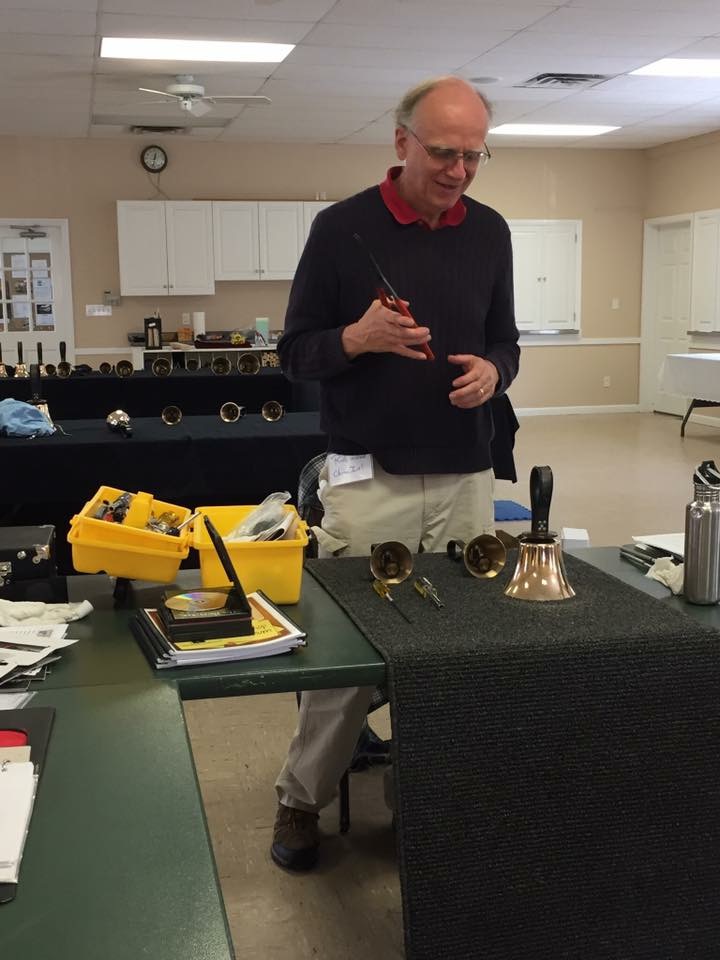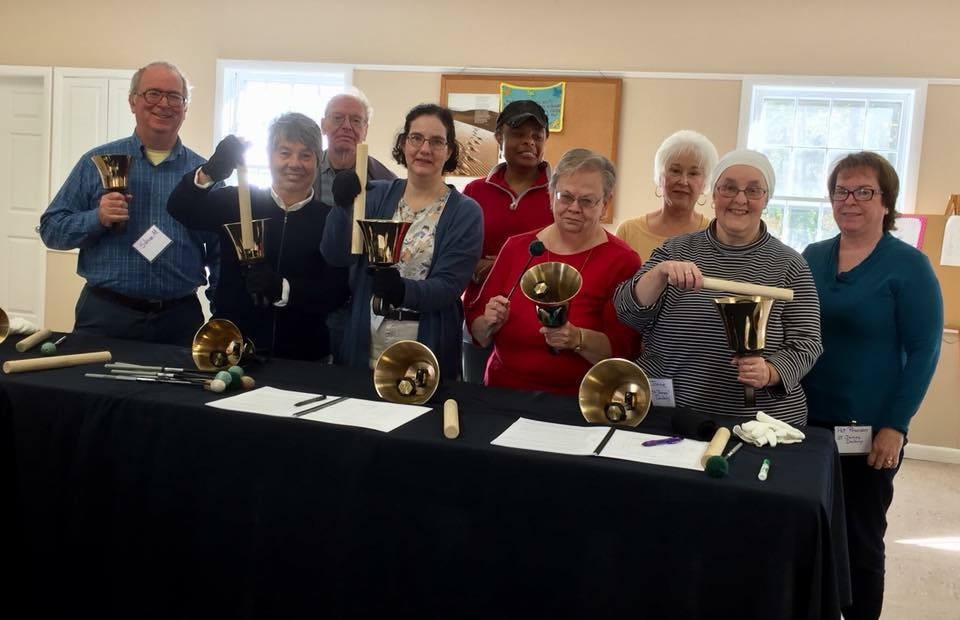This Spotlight article is written by Steve Mazeau after he attended a 2017 Back to Bells event. Area 1 Back To Bells workshops are sponsored by the national Handbell Musicians of America, but draws from the experience and leadership of the members of Area 1. The goal of these workshops is to get bells out of the closets and into the hands of people who will be inspired to start (or continue) ringing with spirit.
Inspire vs. Expire
By Steve Mazeau
The first bell choir I joined expired after about three years when the director moved away. My search for alternatives began in the yellow pages of the phone book under “churches.” This set in motion a series of transitions as I went, for one reason or another, from bell choir to bell choir. While this might seem to be a problem, I found that at each of these different places I was inspired by the different people I met, the styles and techniques they were using and the different music they employed.
The Handbell Musicians of America “Back to Bells” program is really all about this Inspire / Expire dynamic. When the bells disappear into a closet or attic, that’s the expire part of it. This is a bad thing. But don’t panic; they’re not dead, just sleeping. Nor is the inspirational part of the program just limited to our “beautiful dreamers.” I feel that each of us, regardless of our skills and experience, and regardless of where our program may currently be at, can take away a little bit of inspiration from a program like Back to Bells, even when we least expect it.
I recently had the pleasure to be part of a Back to Bells program, led b y Rick Wood at the First Church of Bethlehem in Bethlehem, Connecticut. The program comes with a 43 page, spiral bound, workshop curriculum booklet. The booklet covers a little bit of everything and obviously a great deal of time was spent putting it together. It explains everything from basic ringing techniques and note values to how to set up your rehearsal room and techniques for recruiting new ringers. Have you ever taken a handbell apart to try to resolve a mechanical problem? It’s really not as bad as dissecting a frog in Biology class, but it immediately crosses over into the do-able column when you see someone actually doing it. The booklet includes a section on “Troubleshooting Common Problems” along with information on where you can go if you want to learn more. There are also suggestions in the booklet for repertoire for newer ringers as well as fewer ringers.
y Rick Wood at the First Church of Bethlehem in Bethlehem, Connecticut. The program comes with a 43 page, spiral bound, workshop curriculum booklet. The booklet covers a little bit of everything and obviously a great deal of time was spent putting it together. It explains everything from basic ringing techniques and note values to how to set up your rehearsal room and techniques for recruiting new ringers. Have you ever taken a handbell apart to try to resolve a mechanical problem? It’s really not as bad as dissecting a frog in Biology class, but it immediately crosses over into the do-able column when you see someone actually doing it. The booklet includes a section on “Troubleshooting Common Problems” along with information on where you can go if you want to learn more. There are also suggestions in the booklet for repertoire for newer ringers as well as fewer ringers.
But Back to Bells isn’t just about the booklet and the curriculum, it’s also about the people. Rick Wood obviously has a wealth of knowledge and experience to call upon when it comes to handbell related topics. Rick also took the time to contact each of the Back to Bells participants before the program to see what they wanted to focus on. When we were all done, he also emphasized the fact that he’s only a phone call or e-mail away if anyone needs help in the future.
Back to Bells is really just part of the larger story.  There are so many ways to participate and be inspired. Area 1 is also lucky to have programs like the Family and Friends Handbell Camp, all the different Spring Ring events, the High School Ring Out, the Festival Conference, Snag-a-Sub, Skill Building Workshops, and so on. Behind each of these programs are dedicated people who want to see your program succeed. When you take part in these programs you meet people, much like yourself, each looking for something, and each carrying with them a little bit of inspiration that they can pass on to you. I had the pleasure to meet Joanne Archibald and several of her group from St. James Episcopal Church in Danbury at the Back to Bells event. Equally important, believe it or not, you also carry with you a bit of inspiration that will be passed on to them, and it will happen when you aren’t even expecting it!
There are so many ways to participate and be inspired. Area 1 is also lucky to have programs like the Family and Friends Handbell Camp, all the different Spring Ring events, the High School Ring Out, the Festival Conference, Snag-a-Sub, Skill Building Workshops, and so on. Behind each of these programs are dedicated people who want to see your program succeed. When you take part in these programs you meet people, much like yourself, each looking for something, and each carrying with them a little bit of inspiration that they can pass on to you. I had the pleasure to meet Joanne Archibald and several of her group from St. James Episcopal Church in Danbury at the Back to Bells event. Equally important, believe it or not, you also carry with you a bit of inspiration that will be passed on to them, and it will happen when you aren’t even expecting it!
